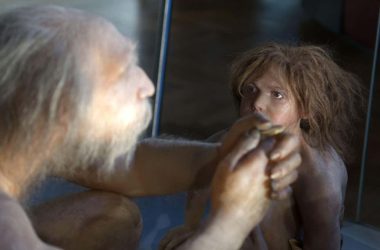The 1000-year-old mind of a person excavated from a churchyard in Ypres, Belgium. The folds of the tissue, that are nonetheless tender and moist, are stained orange with iron oxides
Alexandra L. Morton-Hayward
A research of human brains which were naturally preserved for a whole lot or 1000’s of years has recognized 1300 instances the place the organs have survived even when all different tender tissues have decomposed. A few of these brains are greater than 12,000 years previous.
“Brains of this kind, the place they’re the one tender tissue preserved, have been present in sunken shipwrecks and in waterlogged graves the place the bones are simply floating,” says Alexandra Morton-Hayward on the College of Oxford. “It’s actually, actually unusual.”
“We’re not anticipating a mind to protect in any kind of atmosphere, to be sincere,” she says. “If, as an archaeologist, I dig up a grave and I discover a mind rattling round in a cranium, I might be shocked. However significantly, we’re not anticipating tender tissues to protect in waterlogged environments.”
Morton-Hayward first turned inquisitive about mind preservation whereas working as an undertaker. “The mind is understood to be one of many first organs to decompose autopsy. I noticed it liquefy fairly rapidly. However I additionally noticed it protect,” she says.
Many researchers have famous that human brains are discovered preserved extra usually than anticipated and in shocking circumstances, says Morton-Hayward. Now, she and her colleagues have executed the primary ever systematic research of the phenomenon. They’ve put collectively a database of greater than 4400 preserved human brains discovered all around the world.
They’ve additionally collected and studied many preserved brains themselves. “I did put one in an MRI machine, which was a horrible mistake. I didn’t realise how a lot iron was in there,” says Morton-Hayward.
Typically, the mind preservation could possibly be defined by recognized processes. For example, the brains of Incan human sacrifices entombed on prime of a volcano in South America round AD 1450 have been freeze-dried together with the our bodies, says Morton-Hayward.
The our bodies and brains of bathroom individuals reminiscent of Tollund Man, who was hanged and dumped in a bathroom 2400 years in the past in what’s now Denmark, have been preserved by a tanning course of much like that used for leather-based.
And saponification, the place fatty substances flip right into a type of cleaning soap known as grave wax, preserved the brains of some individuals shot in 1936 throughout the Spanish Civil Battle and buried in a mass grave.
However the recognized processes protect all tender tissues, not simply brains. They don’t clarify the 1300 instances the place brains are the one tender tissue to outlive.
“This unknown mechanism is totally totally different,” says Morton-Hayward. “The important thing function of it’s that we solely have the mind and the bones left. There’s no pores and skin, no muscle, no intestine.”
For example, Saint Hedwig of Silesia was buried in Poland in 1243. When her physique was exhumed within the seventeenth century, her mind was discovered to be preserved, which on the time was attributed to divine energy.
Alexandra Morton-Hayward holding a 1000-year-old preserved mind
Graham Poulter
Morton-Hayward’s working speculation is that, in sure circumstances, substances reminiscent of iron can catalyse the formation of cross-links between proteins and lipids, forming extra steady molecules that resist degradation. The character of the proteins and lipids present in brains, or their ratio, is likely to be the important thing.
“The mechanisms are comparable to those who we see in neurodegenerative illnesses, like dementia,” she says. “So if we will determine what’s occurring to brains after demise, we’d have the ability to shed some gentle on what’s occurring in mind ageing in life as nicely.”
“It’s incredible information that the info is being revealed,” says Brittany Moller at James Cook dinner College in Melbourne, Australia, one of many researchers who has discovered that brain preservation is more common than thought. “It could enhance consciousness amongst researchers of the probably potential for mind materials preservation,” she says.
That’s essential as a result of preserved brains usually have the identical color as surrounding soil. “It’s due to this fact extremely probably that mind materials is continuously discarded throughout archaeological excavation as it isn’t recognised for what it’s,” says Moller.
Whereas the research centered on human brains, the findings ought to apply to animals too. There are at the very least 700 cases of animal brains preserved in fossils, says Morton-Hayward, with the oldest being arthropods which can be half a billion years previous.
Subjects:












